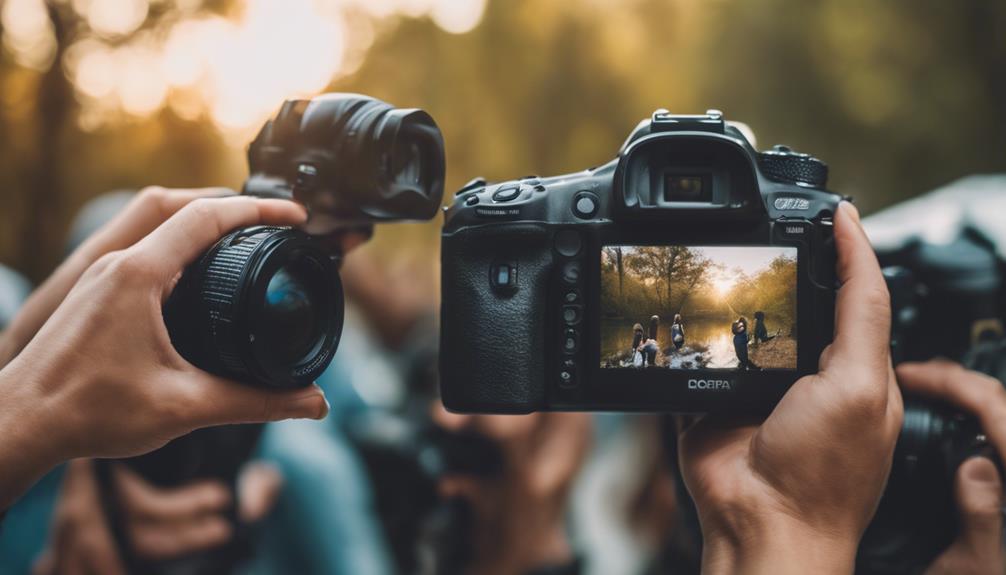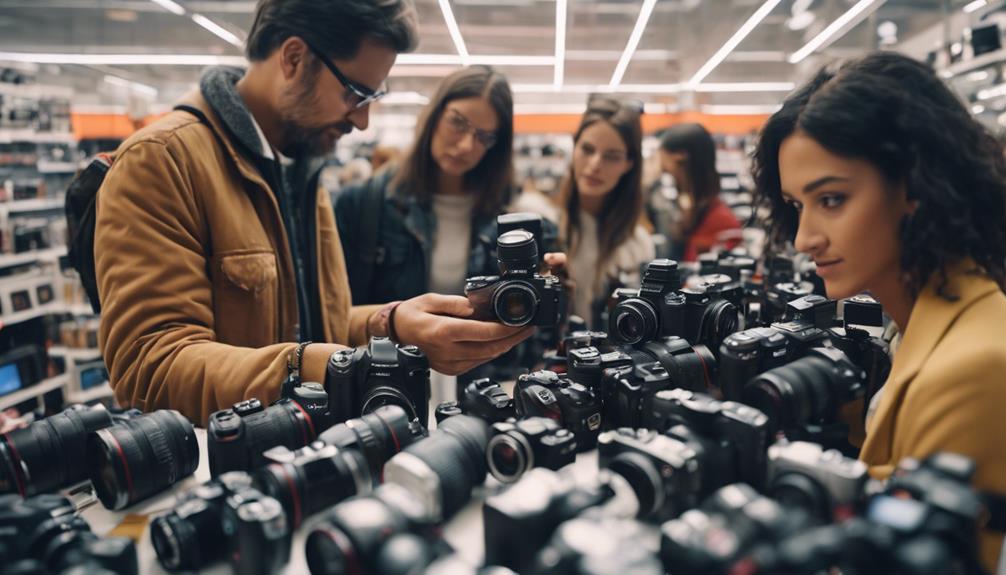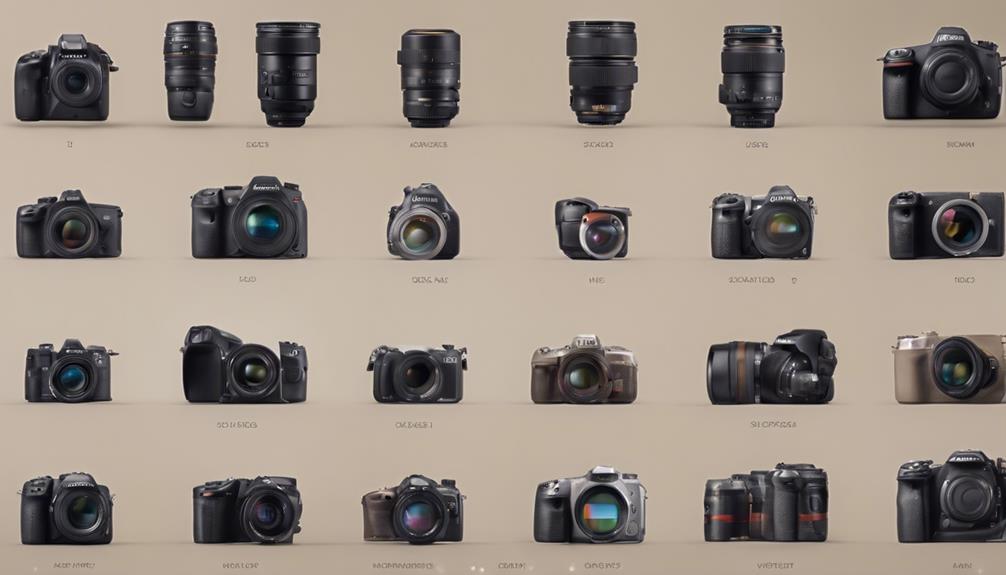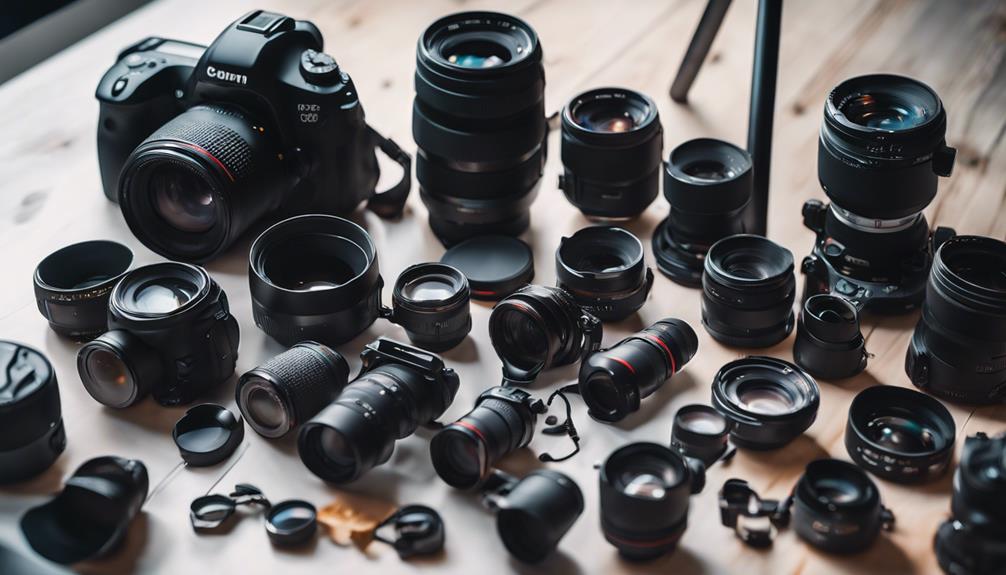To find the right camera, you'll first need to define your photography goals and the subjects you'll be shooting. Consider how often you'll be using the camera and under what light conditions. Next, explore different camera types—DSLRs, mirrorless, compact, bridge, and action cameras—focusing on lens compatibility and image stabilization features that suit your needs. Budgeting is important, so set a clear limit, but also factor in potential extra costs for accessories. Look at sensor sizes to understand how they affect image quality and depth of field. Finally, delve into user reviews and check accessory compatibility. More insights await beyond these basics.
Assess Your Photography Goals

Before selecting a camera, you must clearly define your photographic objectives, considering factors like subject matter, typical shooting conditions, and desired image quality. You'll need to evaluate how often you plan to use the camera. If your shooting frequency is high, you'll require a durable model that can withstand frequent use without compromising on performance. Assess whether you'll be shooting mostly outdoors or indoors, as this will influence your choice based on how the camera handles various lighting conditions.
For instance, if you're into nature photography, you'll encounter a range of lighting scenarios from the bright midday sun to the dim light of dusk. You'll need a camera with a high dynamic range and good ISO performance to guarantee crisp, clear images under varying lighting conditions. Alternatively, if your focus is on indoor events or portrait photography, look for features like a fast autofocus system and the ability to shoot at wider apertures to manage lower light environments effectively.
Understanding these specific needs will direct you towards a camera that not only meets your technical requirements but also enhances your shooting experience, ensuring that you capture high-quality images consistently, regardless of the shooting frequency or lighting conditions.
Understand Camera Types
To make an informed decision, you'll need to understand the different types of cameras available, each tailored to specific shooting needs and technical preferences. Diving into the technicalities, you'll find that lens compatibility and shooting modes vary greatly across camera types, impacting both functionality and user experience.
Here's a breakdown of common camera types:
| Camera Type | Lens Compatibility | Key Shooting Modes |
|---|---|---|
| DSLR | Interchangeable | Manual, Aperture Priority, Auto |
| Mirrorless | Interchangeable | Manual, Shutter Priority, Auto |
| Compact | Fixed | Auto, Scene Modes |
| Bridge | Fixed, but versatile zoom | Program, Scene Modes, Manual |
| Action | Fixed ultra-wide | Auto, Custom Presets |
DSLRs offer robust build quality with a wide range of interchangeable lenses, ideal for both beginners and professionals seeking precision. Mirrorless cameras provide similar lens flexibility but in a more compact and lighter body, often featuring faster shooting speeds and enhanced video capabilities. Compacts are great for everyday use, with limited manual controls and built-in lenses. Bridge cameras fill the gap between compact and DSLRs, offering extended zoom capabilities without the bulk of lens changes. Finally, action cameras are designed for durability and portability, optimized for capturing high-speed activities with minimal adjustments.
Each type supports various shooting modes, from fully automatic to highly customizable manual controls, allowing you to adapt quickly to different photography scenarios. Understanding these aspects will guide you in matching a camera's features with your specific photography ambitions.
Consider Your Budget

Having explored various camera types and their features, you should next evaluate how those options align with your financial constraints. It's important to integrate financial planning early in your selection process.
Cameras range greatly in price, influenced by specifications and capabilities that may exceed what's essential for your needs. Establishing a clear budget requires understanding the overlap between desired camera functions and available financial resources.
Start by setting a firm spending limit. This isn't just about picking a number; it's about evaluating your disposable income and long-term value from your investment. Consider not only the immediate cost of the camera but also potential expenses like accessories, maintenance, and upgrades.
Are there features you can compromise on to stay within budget? Or, perhaps, is there a justification for stretching your budget to secure a camera that will satisfy your needs longer?
Explore Key Features
Once you've set a budget, it's important to examine the key features that will best meet your photography needs. Delving into technical specifications can seem intimidating, but understanding a few important elements can greatly enhance your choice. Two such aspects are lens compatibility and image stabilization, pivotal for both novices and seasoned photographers.
Lens compatibility refers to the ability of your camera body to accommodate various lenses. This flexibility is vital for adapting to different photography scenarios, such as landscapes or portraits. On the other hand, image stabilization helps to minimize blurriness caused by small, involuntary hand movements, important when shooting in low light or at slower shutter speeds.
Here's a quick guide to help you understand these features better:
| Feature | Benefit | Ideal for |
|---|---|---|
| Lens Compatibility | Allows use of diverse lenses for varying photographic needs. | Versatile shooting styles. |
| Image Stabilization | Reduces camera shake, enhancing image clarity. | Low light environments. |
| Autofocus System | Quick and precise focus adjustments. | Action and sports photos. |
Compare Sensor Sizes

Sensor size significantly influences your camera's image quality and depth of field, crucial factors to consider when selecting the perfect model for your photography objectives. Fundamentally, a larger sensor enhances both sensor performance and low light capability, by capturing more light and offering finer details in your photographs.
You'll encounter a variety of sensor sizes in the market: Full-frame, APS-C, Micro Four Thirds, and others. Full-frame sensors, measuring 36mm x 24mm, are the largest commonly available. They deliver a shallow depth of field, enabling a distinct bokeh effect, which is ideal if you're looking to capture portraits or emphasize subjects against a blurred background.
The APS-C sensors are slightly smaller, thus providing less bokeh and slightly reduced detail in low light situations compared to full-frame sensors. Nevertheless, they often strike a good balance between cost, size, and performance for many enthusiasts and semi-professionals.
Micro Four Thirds sensors are even smaller, and while they offer increased depth of field, which could be advantageous for landscape and street photography, they typically don't perform as effectively in low light conditions as the larger sensors.
When making your decision, consider how sensor size influences your specific photographic requirements, particularly focusing on how it will enhance or restrict your intended shooting scenarios and subjects.
Read User Reviews
Read user reviews to gain insights from real-world experiences that can highlight potential strengths and weaknesses not apparent in specifications alone. Delving into user reviews allows you to analyze biases and assess review credibility, ensuring you're not swayed by isolated experiences or overly promotional content.
Here's how you can effectively analyze user reviews:
| Strategy | Purpose |
|---|---|
| Identify Patterns | Look for repeated mentions of features or issues; patterns indicate common experiences. |
| Check Reviewer Profiles | Assess the reviewer's history and expertise to judge the credibility of their opinions. |
| Analyze Star Ratings | Dissect the distribution of ratings to understand the balance of satisfaction and dissatisfaction. |
| Read Extreme Reviews | Examine 1-star and 5-star reviews to understand the best and worst aspects as perceived by users. |
When you're sifting through reviews, pay attention to detailed feedback rather than generic praise or criticism. It's important to take into account the context in which reviewers used the camera. For example, a professional photographer's expectations might differ significantly from those of a casual user. This nuanced approach will provide a thorough understanding of how the camera performs in diverse conditions and for various purposes. Remember, analyzing biases and verifying the sources of reviews is key to forming a well-rounded view of the product.
Check Accessories Compatibility

Before purchasing a camera, confirm its compatibility with essential accessories such as lenses, tripods, and external flashes to maximize its functional potential. Explore the accessory ecosystem specific to the camera model you're considering. Examine whether the camera body supports universal mount types or if it necessitates proprietary connections, which can limit your options or increase costs.
Focus on mount adaptability; this determines the variety of lenses you can use, impacting not only photographic quality but also the genres you can proficiently capture, from wide-angle landscapes to detailed macro shots. Check if the camera's mount is actively supported by major lens manufacturers, ensuring accessibility to high-quality optics.
Evaluate compatibility with external flashes and lighting rigs, especially if you plan to immerse yourself in professional photography or complex lighting scenarios. Make sure that the camera's hot shoe or wireless connectivity options support a wide range of flash models and lighting systems for maximum flexibility.
Lastly, don't overlook the support for advanced accessories like gimbal stabilizers and external recorders, which are essential for videography. The camera's interface should facilitate seamless connections with these devices without requiring excessive adapters or compromising signal integrity. Prioritizing these compatibility checks ensures you invest in a camera that truly fits your evolving photographic needs.
Evaluate Warranty Options
When selecting a camera, it's important to assess the warranty options provided, focusing on coverage extent, duration, and the inclusion of international support. You'll want to look closely at the repair coverage details. Are sensor malfunctions or lens issues covered? What about accidental damage? It's vital to understand the specifics, as the scope of repair coverage can greatly impact your long-term satisfaction and the camera's upkeep costs.
Duration is another key element. Standard warranties might range from one to three years, but some manufacturers offer extended warranties at an additional cost. Consider how long you plan to use the camera and whether the extra expense for extended coverage aligns with your needs.
Pay attention to the availability of service centers, especially if you travel often. A warranty with international support ensures that you can access service facilities around the globe, minimizing downtime during your travels. Check if the manufacturer has service centers in the locations you frequent most.
Lastly, review the claim process. Is it straightforward? How quickly do the service centers operate on average? Efficient customer service can greatly reduce the inconvenience of camera repairs. Always read the fine print to avoid any future surprises or disappointments.
Frequently Asked Questions
How Does Weather Affect Different Camera Types?
Weather impacts various camera types greatly due to their weather durability and temperature sensitivity. If you're using a DSLR, moisture and extreme temperatures can damage internal components, while action cameras are generally more resilient. Mirrorless cameras require careful handling in adverse conditions.
Always check the weather-sealing features of your camera to make sure it can withstand specific environmental conditions. Investing in weather-resistant gear might be crucial if you frequently shoot in variable climates.
Can I Use Vintage Lenses With New Digital Cameras?
Yes, you can use vintage lenses with modern digital cameras if you check for lens compatibility. You'll need the right adapter types to bridge the mechanical and electronic differences.
Make sure the adapter you choose accurately translates the lens's focal length and aperture settings to your camera. Researching the specific lens mount and adapter compatibility is essential, as mismatching can affect image quality and functionality.
Always verify with detailed compatibility charts available from manufacturers or specialized forums.
What Are the Best Camera Brands for Beginners?
When you're starting out, Canon and Nikon capture 70% of the beginner camera market, thanks to their brand reliability and robust beginner models. These brands offer extensive DSLR and mirrorless options, which are essential for learning the basics.
Sony also stands out, especially in mirrorless technology, providing compact and technologically advanced models ideal for novices wanting high-quality images without the bulk. Each brand supports a wide lens ecosystem, enhancing your photographic flexibility as you advance.
How Often Should I Service My Camera?
You should service your camera based on its usage and environment, but typically, annual maintenance is recommended. Service intervals can vary; however, frequent use or harsh conditions might necessitate bi-annual check-ups. Keeping track of maintenance costs is important as they can add up, especially with high-end models.
Regular servicing ensures your camera operates efficiently, preventing costly repairs or replacements due to neglect. Always consult your camera's manual for specific maintenance guidelines.
Are There Cameras That Support Multiple Languages?
Yes, many modern cameras support multiple languages, enhancing language accessibility for users globally. You'll find that language settings can typically be adjusted in the camera's menu.
Additionally, manufacturers often release firmware updates that might include additional languages or improve existing language packs. It's crucial to check these updates to guarantee your camera remains up-to-date with the latest language support and technical enhancements, optimizing your user experience.
Conclusion
Now that you've navigated the nuances of camera capabilities and conquered the complexity of choices, you're on the brink of buying brilliance.
Remember, re-evaluating your real requirements and reading relentless reviews refines your resolution.
Don't dismiss the details of sensor sizes or skimp on scrutinizing specs. A compatible collection of accessories and airtight warranty will warrant worry-free wonders.
With your budget balanced and goals gauged, grasp your perfect photographic partner and capture creations confidently. Embrace your expertise, engage enthusiastically, and enjoy every expedition.

